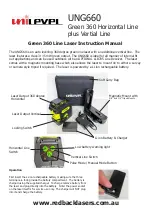
4. Power supply
4.1 TCL - 80
As soon as the battery indicator lamp (15) blinks, the batteries must be recharged.
Open the battery cover (7), remove the batteries and put them in the charging box
for recharging. When the batteries have been charged a green LED on the
charging box lights up. Put the batteries back in the laser’s battery compartment.
Pay attention to place the batteries correctly (see instruction in the battery case). If
you use Alkaline batteries dispose the old batteries appropriately and exchange
them with new Alkaline batteries (size AA).
4.2 Detector
If the LED (22) blinks, the battery (9V, E-Block) should be replaced, because if
not, the range can be restricted.
Unscrew the screw (24) of the battery cover and take off the cover. Dispose of the
old battery appropriately and pay attention to the correct polarity of the new
battery (see symbol in battery case). After that, attach again the battery cover.
5. Detector TEK
Switch on the detector by pressing the button (23). The operation display (22)
shows the switched on status.
Choose fine or coarse adjustment with the button Mode (30) (basic setting is fine).
In the fine range the LED (28) illuminates. In the coarse range the LED is switched
off.
The acoustic signal can be switched off or activated with the button (29) (basic
setting is Buzzer On).
To adjust or detect the laser lines the sensor window (25) of the TEK has to be
oriented in the direction of the TCL-30. The inclination of the detector can be
controlled using the built in levels (18).
Adjust the center line (26) of the TEK parallel to the laser line and, after that, move
the detector slowly in the direction of the laser line till one of the arrow symbols
(19/21) illuminates.
After that, move the detector to the center until only the center-LED (20)
illuminates constantly. If the buzzer is activated (31) there will be a permanent
sound with the center display. When the arrows are displayed there will be a
pulsating sound, which will be different, depending on the direction the detector
needs to be shifted to reach the center. For a clear distinction, both LEDs of the
arrow symbols illuminate in different colors.
Arrow symbol and center display are arranged at the front, at the back and at one
face side of the detector, so that it is possible to read off the data in every position
of the detector.
If for approx. 6 minutes no laser line hits the beam receiving window (sensor
window) (25), the detector switches off. There will be a short sound, if the buzzer
is switched on.
TEK
(18) Level
(25) Sensor window
(19) Arrow symbol LED red
(26) Center line
(20) Center display LED green
(27) Notch center
(21) Arrow symbol LED orange
(28) Display fine range On
(22) Operation and battery control display (29) Button Buzzer
(23) Button On / Off
(30) Button Mode: Fine / Coarse
(24) Screw battery cover
(31) Acoustic signal exit (buzzer)
15
16
6. Controlling the adjustment
6.1 Horizontal laser line
Set up the TCL-80 as described in 2. Then align it along an approximately 10 m
long measuring section in X – and Y-axis.
At the end of the measuring section make a marking in the height of the horizontal
laser line. After that, turn the TCL-80 consecutively for approx. 35° to the right and
after that for approx. 35° to the left starting fro m the X -axis and control, if the height
of the laser line changes compared with the marking. Same procedure make in the
Y –axis. If none or only an insignificant (maximum 4 mm) difference in height can be
determined the adjustment is all right. If there are bigger deviations, the instrument
needs to be controlled and newly calibrated by a specialized service-center.
6.2 Vertical laser line
Set up the TCL-80 as described in 2. Then do a plumbing at an absolute vertical
measuring section of at least 3 m in height - which was defined beforehand by a
base- and an end point.
Position the TCL-80 in a distance of approx. 1 m in front of the base point in a right
angle to the measuring section, and, in doing so, align the vertical line in such way,
that the line hits the base point. If the line also hits the end point, the adjustment is
all right.
Apply that control for all vertical lines X and Y.
In case of bigger deviations have the instrument newly calibrated by a specialized
service-center.
17
7. Supplier's declaration/Safety instructions
The unit is designed in accordance with the European Standards 89/336/EEC
Electromagnetic Compatibility (EMC) and 73/23/EEC Electric Equipment for use
within certain voltage limits (Low-voltage Directive).
For evaluation purposes, the harmonized Standards EN 55011 Class B (EN
61000-6-1), EN 61000-6-2, EN 61010-1 and EN 60825-1 have been applied.
Safety information label is placed on the case of the instrument.
A Class 3R embedded laser has been installed. On opening the unit, be
aware that higher energy levels than Class 2 are present. If possible, avoid
pointing the laser in the direction of persons. Do not look into the laser
beam, also not with optical instruments.
There are no parts requiring maintenance or adjustment inside the unit.
Service operations are only to be carried out by authorized workshops.
18
(28)
(29)
(27)
(30)
(31)
(18)
(26)
(25)
(22)
(23)
(21)
(18)
(24)
(20)
(19)

















